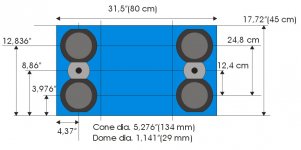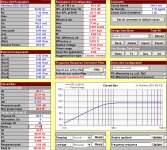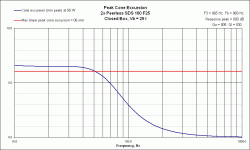Hey all, I think this is a better forum to ask in since this'll be a two way boombox.
I'm building a battery powered boombox, something along the lines of the Boominator (there's an instructable by "lutkeveld") but more reasonable. The general idea is to make it 1) loud, 2) have acceptable low frequency response, and 3) have at least 6 hours of battery life at high volume. I've been reading up quite a bit on the electrical side of things and I think making the enclosure as acoustically correct as possible is necessary to maximize battery life and low frequency response. Stop me here if that's wrong. The boombox will most likely have 4 drivers - 2x 8" or 10" woofers and 2 tweeters. Parts Express has "optimal cabinet dimensions" for their woofers, and I understand what cabinet size means: this many internal cubic feet will give you the best response. Vented boxes let the speakers hit lower frequencies, so my plan is to build a vented cabinet.
What I'm a little stuck on: "Vented F3". My understanding is this is effectively the corner frequency where the sub starts rolling off. I know the physical dimensions of the box determine F3. What I don't know is how do you design a box to have a specific F3? Or if you already know the measurements, how do you calculate F3? And regarding the vent: do I need to have a tube on the inside (like in most bass reflex ports) or can it just be literally a hole cut in the side of the speaker as it is in the Boominator (in lutkeveld's instructable)? And how do you calculate the size of the hole or the size and length of the pipe?
Going further with the vent, I've heard of needing a *high* pass filter on woofers to prevent them from damaging themselves at inaudible frequencies (say 40Hz for a portable system like this). Would it be a good idea to include this in the design of a fairly high-output system like I'm trying to build? Or would it just be a waste of time because these drivers will be running from either a 2x15W or 2x25W amplifier?
Google has led me to good explanations of what everything means, but not much in the way of "how do I actually calculate these dimensions". Also if you can offer any pointers on portable speaker design, I'd be happy to listen.
I'm building a battery powered boombox, something along the lines of the Boominator (there's an instructable by "lutkeveld") but more reasonable. The general idea is to make it 1) loud, 2) have acceptable low frequency response, and 3) have at least 6 hours of battery life at high volume. I've been reading up quite a bit on the electrical side of things and I think making the enclosure as acoustically correct as possible is necessary to maximize battery life and low frequency response. Stop me here if that's wrong. The boombox will most likely have 4 drivers - 2x 8" or 10" woofers and 2 tweeters. Parts Express has "optimal cabinet dimensions" for their woofers, and I understand what cabinet size means: this many internal cubic feet will give you the best response. Vented boxes let the speakers hit lower frequencies, so my plan is to build a vented cabinet.
What I'm a little stuck on: "Vented F3". My understanding is this is effectively the corner frequency where the sub starts rolling off. I know the physical dimensions of the box determine F3. What I don't know is how do you design a box to have a specific F3? Or if you already know the measurements, how do you calculate F3? And regarding the vent: do I need to have a tube on the inside (like in most bass reflex ports) or can it just be literally a hole cut in the side of the speaker as it is in the Boominator (in lutkeveld's instructable)? And how do you calculate the size of the hole or the size and length of the pipe?
Going further with the vent, I've heard of needing a *high* pass filter on woofers to prevent them from damaging themselves at inaudible frequencies (say 40Hz for a portable system like this). Would it be a good idea to include this in the design of a fairly high-output system like I'm trying to build? Or would it just be a waste of time because these drivers will be running from either a 2x15W or 2x25W amplifier?
Google has led me to good explanations of what everything means, but not much in the way of "how do I actually calculate these dimensions". Also if you can offer any pointers on portable speaker design, I'd be happy to listen.
Hi,
Look at the Peerless or Monacor (where are you sourcing the drivers?).
A +/- 1cf reflex, the SPH200-tc for a small ~15L and 93dB (high F3) and the 205WR33 for a larger ~20/25Liter and lower 91dB (55's F3 in Hz) with better LF extension, obvious better bass.
F3 is the frequency lower 3 dB point from main sensitivity of the driver.
Look at the Peerless or Monacor (where are you sourcing the drivers?).
A +/- 1cf reflex, the SPH200-tc for a small ~15L and 93dB (high F3) and the 205WR33 for a larger ~20/25Liter and lower 91dB (55's F3 in Hz) with better LF extension, obvious better bass.
F3 is the frequency lower 3 dB point from main sensitivity of the driver.
Hi,
Look at the Peerless or Monacor (where are you sourcing the drivers?).
A +/- 1cf reflex, the SPH200-tc for a small ~15L and 93dB (high F3) and the 205WR33 for a larger ~20/25Liter and lower 91dB (55's F3 in Hz) with better LF extension, obvious better bass.
F3 is the frequency lower 3 dB point from main sensitivity of the driver.
I'll be buying the drivers from Parts Express most likely. So for making the actual reflex cabinet, how do I design the vent? Is it a simple "area of hole vs volume of cabinet" equation or does that shape come into play as well?
Hi,
It's a Helmholtz Resonator. Look in Google for info.
Some basics on the tech aspects.
http://hyperphysics.phy-astr.gsu.edu/hbase/waves/cavity.html
Strassacker: Speaker Building, Components
To make a project using the driver you are looking for (alignment/driver/enclosure) then a simulation software should be helpful, just like WinISD or Unibox.
It's a Helmholtz Resonator. Look in Google for info.
Some basics on the tech aspects.
http://hyperphysics.phy-astr.gsu.edu/hbase/waves/cavity.html
Strassacker: Speaker Building, Components
To make a project using the driver you are looking for (alignment/driver/enclosure) then a simulation software should be helpful, just like WinISD or Unibox.
I've been reading up quite a bit on the electrical side of things and
I think making the enclosure as acoustically correct as possible is necessary to maximize battery life and low frequency response.
Larger drivers usually need larger box volumes and paralleling drivers
doubles the volume needed for the same F3.
I don't know what kind of a budget you have in mind, but if I were to
build one, I'd first define the budget limit, then calculate the project
feasibility.
Larger drivers usually need larger box volumes and paralleling drivers
doubles the volume needed for the same F3.
I don't know what kind of a budget you have in mind, but if I were to
build one, I'd first define the budget limit, then calculate the project
feasibility.
Interesting, do you know of any sources that explain the theory behind that? I was under the impression that regardless of how many drivers you had, the "optimal" F3 was always the same as long as you had the same drivers.
And for budget, I'm shooting for under $300. However, I plan on keeping this for a long time so that budget is flexible. Nothing is set yet but the woofers I plan on using are Celestion TF1018 10" Professional Speaker 100W along with these tweeters Tymphany BC25SC06-04 1" Textile Dome Tweeter.
Parts Express say the effective volume of a cabinet increases by 10%-25% depending on the damping material used. I'm assuming that this'll be necessary here to keep the overall dimensions reasonable. I hadn't heard of the "two drivers -> double the volume for the same F3", so until now my proposed dimensions are 23" wide, 13" tall, and 7" deep. Two ports, 1.8" in diameter each, which should tune the box to 58Hz. These won't have a tube on the inside; I figure if I use 1" thick MDF (or whatever building material) then the vent length will be ~1" -> no need for extra parts. I checked a link that talks about chuffing, and with his equation the diameter of the vent needs to be more than about 0.2 inches, so 1.8" vents should be fine. Again, this was assuming F3 was the same for one and two drivers, so I may need more information.
Here's a crude scale drawing (except depth) of my proposed layout: http://i.imgur.com/0NH5Vha.jpg
What amplifier are you planning to use or are you building yourself?
I've been talking to lutkeveld (one of the big supporters/builders of the Boominator portable speaker) and he's designed an amplifier with bluetooth specifically for the Boominator/Boominator-esque designs. If that doesn't work out, I would most likely use this one: Sure Electronics 2x15W at 4 Ohm TA2024 Class-D Audio Amplifier Board Only along with a separate bluetooth receiver module. Everything will be running off a 12V sealed lead acid battery, so I need an amplifier that can run on a 12V supply.
King,...
Parts Express say the effective volume of a cabinet increases by 10%-25% depending on the damping material used. I'm assuming that this'll be necessary here to keep the overall dimensions reasonable. I hadn't heard of the "two drivers -> double the volume for the same F3", so until now my proposed dimensions are 23" wide, 13" tall, and 7" deep. Two ports, 1.8" in diameter each, which should tune the box to 58Hz. These won't have a tube on the inside; I figure if I use 1" thick MDF (or whatever building material) then the vent length will be ~1" -> no need for extra parts. I checked a link that talks about chuffing, and with his equation the diameter of the vent needs to be more than about 0.2 inches, so 1.8" vents ...
You will need 23×13×7" or 34 Liters for each driver.
Interesting, do you know of any sources that explain the theory behind that?
I hadn't heard of the "two drivers -> double the volume for the same F3",
so until now my proposed dimensions are 23" wide, 13" tall, and 7" deep.
Get Unibox or Woofer Box and Circuit Designer spreadsheets and you
will see how things are with box tuning.
I believe box measures should be considered after you do the simulation
based on TS parameters. Celestion is a decent PA driver with its not so
favorable high Fs parameter, although in a large box it would improve
somewhat.
I would suggest considering this driver as a good foundation for bass.
Peerless SDS-160F25PR01-08 6-1/2" Paper Cone Woofer Speaker
Dayton Audio DC28FT-8 1-1/8" Silk Dome Truncated Tweeter
Instead of T amp crap, something that can push the cones
with no current delivery issues.
Pyle PLMRA120 Marine Waterproof 2-Channel Amplifier
Yes too conservative on the 15 -25 watt amplifiers.
Checked out the woofer(s) 2 of them would require a 4.0cf tuned at 60hz would give you 3db at 53hz.
Vents - cut two holes 3.5" for 1" thick wood, no tubes needed.
Woofers, only 2mm xmax btw.
You'll need a truck and a helper to move around a 4cf 1"mdf box - heavy!!
Have you looked a Ion tailgaters? Lightweight, very reasonable $$, plenty of features and they play loud.
Checked out the woofer(s) 2 of them would require a 4.0cf tuned at 60hz would give you 3db at 53hz.
Vents - cut two holes 3.5" for 1" thick wood, no tubes needed.
Woofers, only 2mm xmax btw.
You'll need a truck and a helper to move around a 4cf 1"mdf box - heavy!!
Have you looked a Ion tailgaters? Lightweight, very reasonable $$, plenty of features and they play loud.
I've used a single DVC woofer to keep the box smaller and 2-way coaxial full range (3" dash mount) drivers for the top. Makes life simple. Choke the sub and attenuate the tops.. (If needed)
2-3 watt/channel chip amps that operates at 5 v.d.c. Provides ~12 watts of total power. One for the tops and one for the sub. (Plenty of power for any "Portable" device, IMO..)
I operate my units from a large 5 volt bank battery. Easy to find and easy to charge. Larger the aHr. rating, the longer it runs..
Just some food for thought..
2-3 watt/channel chip amps that operates at 5 v.d.c. Provides ~12 watts of total power. One for the tops and one for the sub. (Plenty of power for any "Portable" device, IMO..)
I operate my units from a large 5 volt bank battery. Easy to find and easy to charge. Larger the aHr. rating, the longer it runs..
Just some food for thought..
Peerless SDS 160 F25 PR01-8 looks so much better
basswise and as a hifi standalone solution. I would
do the boom box as two detachable mtm speakers
with SPL about 90 dB in free space in a sealed 1cu ft
box. The simulation says that Xmax excursion would
not exceed much over Xmax, certainly well from X mech
at 50 W of input power, to each 25W. The centre cabinet
could house all other stuff.
basswise and as a hifi standalone solution. I would
do the boom box as two detachable mtm speakers
with SPL about 90 dB in free space in a sealed 1cu ft
box. The simulation says that Xmax excursion would
not exceed much over Xmax, certainly well from X mech
at 50 W of input power, to each 25W. The centre cabinet
could house all other stuff.
Attachments
That Pyle amp may not be much (or any) more powerful than the T-amp. If the manual can be believed, the "Pile" is fused at 5 amps, so RMS power will be considerably less than 35 watts/channel, (let alone 70 watts), and quite possibly identical to the T-amp. So, try a T-amp; they're well under $10 shipped from eBay sources, and useful for other medium-power projects if it doesn't work out for this one. By the way, these amps deliver about the same power as "high power" car head units, which typically claim similar imaginary high power outputs under unspecified conditions.
Last edited:
Portables are really popular now, (check the bottom of page in the link).
ION Audio Block Rocker iPA76A Portable BLCKRCKR15M2AXUS B&H
ION Audio Block Rocker iPA76A Portable BLCKRCKR15M2AXUS B&H
That Pyle amp may not be much (or any) more powerful than the T-amp.
By the way, these amps deliver about the same power as "high power"
car head units, which typically claim similar imaginary high power outputs
under unspecified conditions.
You are right in the sense that Pyle can't deliver much more than T-amp,
which is by the way no miracle since it costs $42. It is most likely capable
of delivering 2 A per channel and I guess at some 12 V, which is 24 W/4 ohm,
maybe more.
Those T amps you mentioned for under $10 from eBay are Tripath
TA2020 chip based and if you closely observe the spec sheet, you will
see that it is capable of delivering 10 W/4 ohm per channel at 13,5Vdc
power supply and about 6W/8 ohm, low distortion conditions.
10W at 4 ohm=1,58A (6,32 V rms)
6W at 8 ohm=0,87A(6,9 V rms)
So, we see that T-amp is practically the same as the amp in head units.
Last edited:
There's also TA2024 amps, and some more expensive ones that use the Yamaha YDA138 or YDA148. The YDA148 has some useful options for preventing clipping. I got one from dealextreme, but haven't figured out yet if it implements those features. It's a ridiculously tiny chip for something so powerful. The 138 can be strapped for mono operation, so it might serve as a very modest subwoofer amp.
Last edited:
It's a ridiculously tiny chip for something so powerful.
YDA 148 is good at 12V supply voltage for 6-7W/8 ohm load.
- Status
- This old topic is closed. If you want to reopen this topic, contact a moderator using the "Report Post" button.
- Home
- Loudspeakers
- Multi-Way
- DIY boombox. F3 of a DIY enclosure? Vent sizing? HPF to protect woofer?


